Artificial intelligence has advanced despite having few resources dedicated to its development — now investments have increased substantially
Artificial intelligence (AI) technology has steadily become more powerful over the course of the last decades, and in recent years, it has entered our world in many different domains. In a companion article — the brief history of artificial intelligence — I document this development.
This was achieved despite having relatively few resources. Until recently, investments in terms of capital and scientific efforts were small. In this article, I highlight that this has very much changed in recent years. Corporate investment has increased, and the scientific field has grown in size.
Given how rapidly AI has developed in the past despite limited resources, this should make us expect AI technology to continue to become more powerful in the coming decades.
Investments in artificial intelligence
The first chart looks at corporate investment over time.1
Until recently, private sector investment was relatively low. But, especially from 2018 onwards, it has increased rapidly.
Investments in 2021 were about 30 times larger than just eight years earlier.
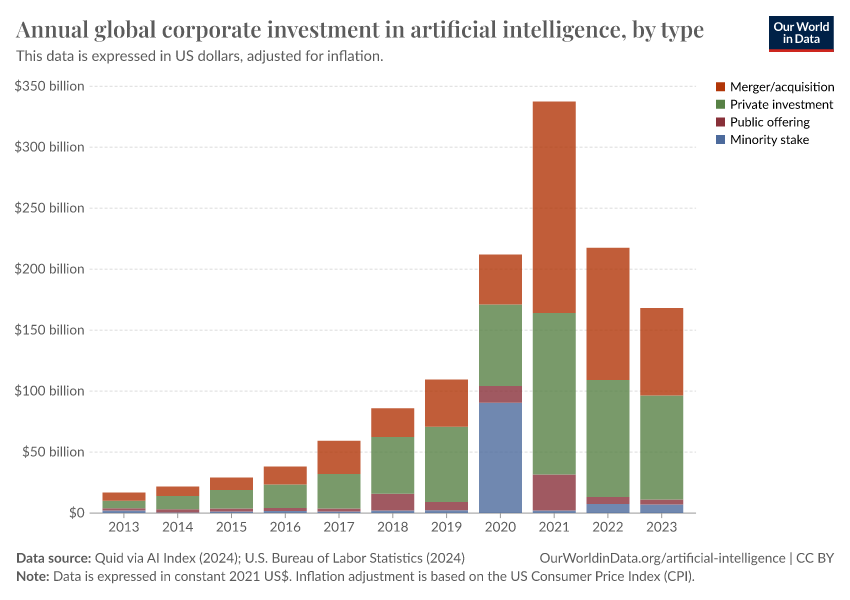
Research and the labor market
The following four visualizations show that the trends for AI research efforts and the labor market are similar.
Just a decade ago the field was much smaller than it is today. Since then the number of research publications on artificial intelligence has doubled, and AI conferences have become much larger events. This is what the first two charts show.
The third chart documents the increasing importance of AI skills in the labor market. The last chart shows the share of organizations that use AI in at least one area of their work.. As AI adoption continues to grow, the demand for AI expertise — and the pace of research — is likely to increase further in the years to come.
Additionally, AI itself is contributing to the development of AI: Researchers are beginning to find ways for AI itself to contribute to the development of AI.2
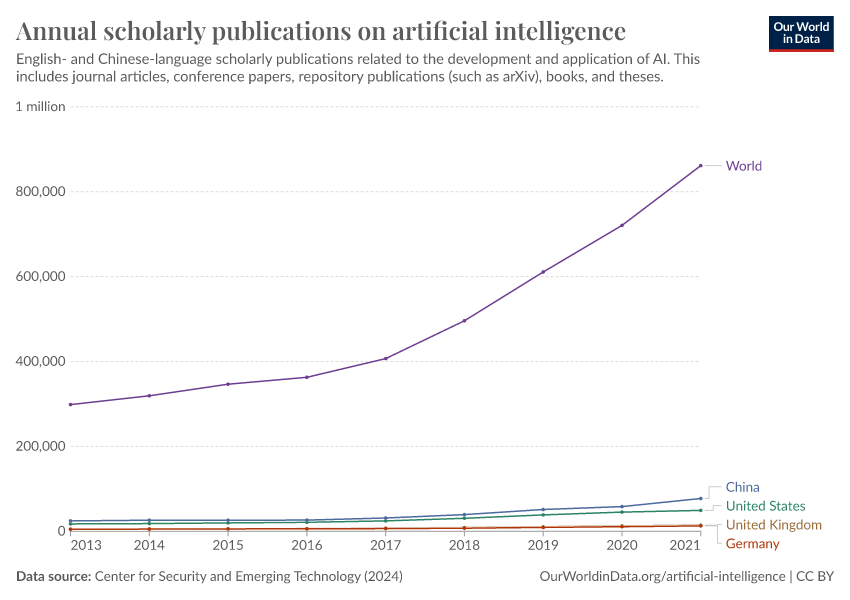
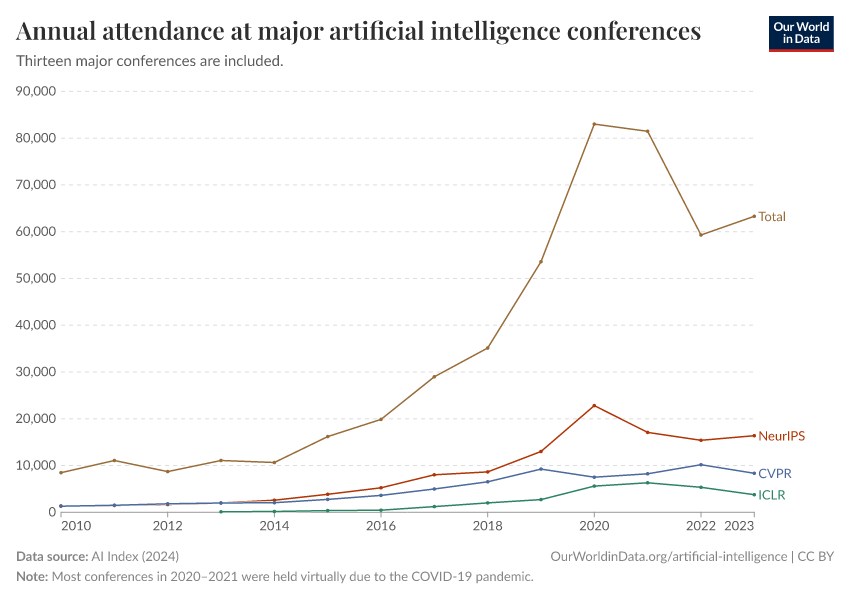
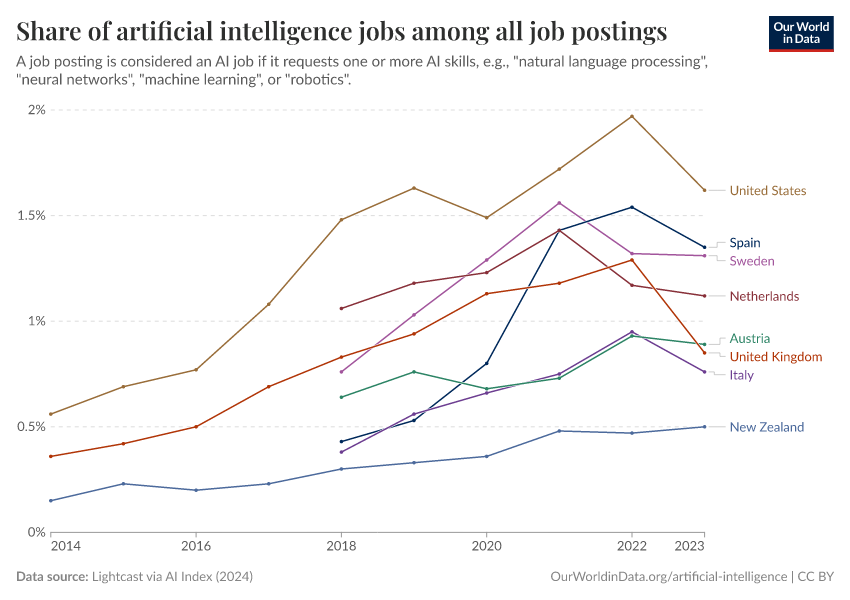
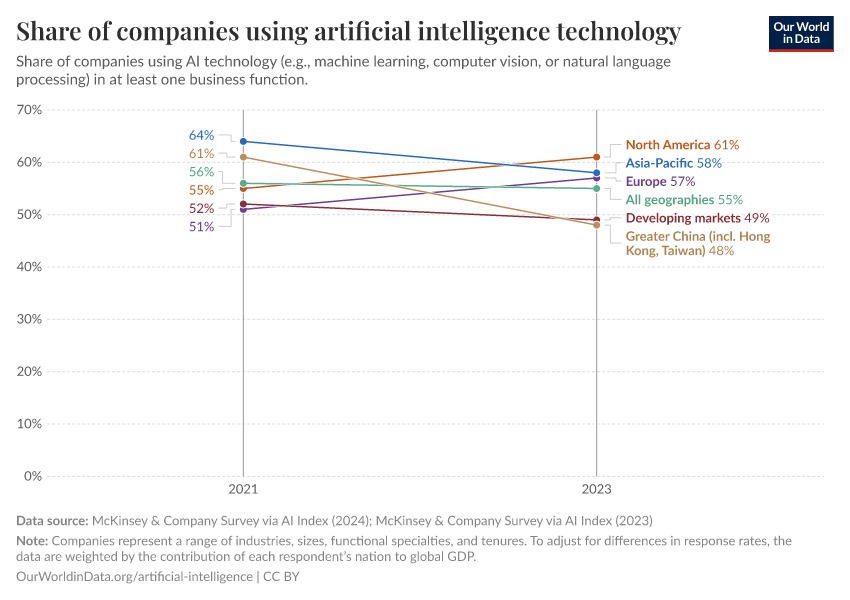
Conclusion
The developments in the past happened despite the fact that funding and brainpower dedicated to AI were quite limited. As these charts have shown, this has changed. Across a range of metrics, the resources dedicated to AI development have increased substantially.
The fact that the field has advanced with relatively small resources, and now has much larger resources at its disposal, leading to rapid advances in the last few years, is one reason why I expect AI technology to continue to develop rapidly and to exert a larger and larger influence on our world.
Acknowledgements: I would like to thank Julia Broden, Charlie Giattino, Joe Hasell, Edouard Mathieu, and Veronika Samborska for their helpful comments on drafts of this essay and the visualizations.
Continue reading on Our World in Data
Explore other charts on the rise of investments in AI technology
- Annual private investment in artificial intelligence
- Annual global corporate investment in artificial intelligence, by type
Endnotes
It is not obvious how to adjust a time series of AI investments for inflation, and we debated it at some length within the team.
Reporting it in nominal prices (as some do) means it makes little sense to compare observations across time and is therefore not very helpful. To make comparisons over time possible one has to take into account that prices change.
It would be straightforward to adjust the time series for price changes if we knew the prices of the specific goods and services that these investments purchased. This would make it possible to calculate a volume measure of AI investments, and it would tell us how much these investments bought. But such a metric is not available.
(While a comprehensive price index is not available, we know that the cost for some crucial AI technology has fallen rapidly. For example, it has become much cheaper to train an AI system.)
In the absence of a comprehensive price index that captures the price of AI-specific goods and services, one has to rely on one of the available metrics for the price of a bundle of goods and services. In the end, we decided to use the US Consumer Price Index (CPI).
The US CPI does not provide us with a volume measure of AI goods and services, but it does capture the opportunity costs of these investments. The inflation adjustment of this time series of AI investments, therefore, lets us understand the size of these investments relative to whatever else these sums of money could have purchased.
One early example of this is Neural architecture search.
Cite this work
Our articles and data visualizations rely on work from many different people and organizations. When citing this article, please also cite the underlying data sources. This article can be cited as:
Max Roser (2023) - “Artificial intelligence has advanced despite having few resources dedicated to its development — now investments have increased substantially” Published online at OurWorldinData.org. Retrieved from: 'https://archive.ourworldindata.org/20260119-065148/ai-investments.html' [Online Resource] (archived on January 19, 2026).BibTeX citation
@article{owid-ai-investments,
author = {Max Roser},
title = {Artificial intelligence has advanced despite having few resources dedicated to its development — now investments have increased substantially},
journal = {Our World in Data},
year = {2023},
note = {https://archive.ourworldindata.org/20260119-065148/ai-investments.html}
}Reuse this work freely
All visualizations, data, and code produced by Our World in Data are completely open access under the Creative Commons BY license. You have the permission to use, distribute, and reproduce these in any medium, provided the source and authors are credited.
The data produced by third parties and made available by Our World in Data is subject to the license terms from the original third-party authors. We will always indicate the original source of the data in our documentation, so you should always check the license of any such third-party data before use and redistribution.
All of our charts can be embedded in any site.